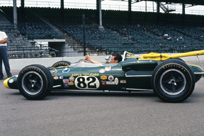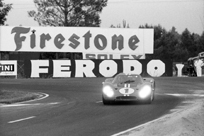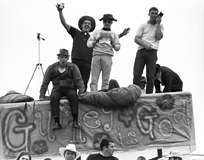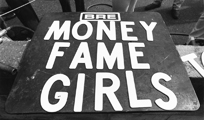| |
The son of a movie producer and actress, Dave Friedman spent most of his professional career as a still photographer on many well-known film productions. In recognition of his professional accomplishments, Friedman is the only still Photographer to be elected into the Motion Picture Academy of Arts and Sciences. Even before beginning his career in Hollywood, Friedman turned his photographic talents to one of his other passions–auto racing.
In 1962, 23-year-old Friedman was hired as staff photographer for Shelby-American Inc., the racing design and construction shop owned by former driver Carroll Shelby. Here, Friedman had the unique opportunity to document the development of one of racing’s iconic cars, the Shelby Cobra. (Click here to hear legendary racecar driver and builder Carroll Shelby talk about building this car and about his career). In 1966 and 1967, Friedman was hired by Ford Motor Company to document the company’s racing program. Friedman captured the final development of the first American-designed and built racecars that dominated the grueling 24-Hours of Le Mans race between 1966 and 1969. After moving into the film industry, Friedman continued to pursue his passion for motor sports into the 1990s, when he refocused his lens on a different art form – classical ballet.
The Dave Friedman Collection consists of more than 200,000 unique images including photographs, negatives, color slides and transparencies. The collection also includes the programs, results and notes from races across the United States and around the world. Dating between 1949 and 2003, the images and programs cover a wide variety of racing, including endurance races at Le Mans, France, and Sebring and Daytona, Florida; the glory years of the Can-Am Series; the Indianapolis 500; Trans-Am racing; and even amateur sports car racing.
The Dave Friedman Collection is a unique resource that documents in vibrant colors and subtle shades the art, power and passion of American automobile racing in the second half of the 20th century.
Examples of images from the collection:
 |
In this May 1965 photograph, racing legend Jimmy Clark pilots the Lotus-Ford racecar to victory at one of racing’s legendary tracks, the Indianapolis Motor Speedway. This innovative car’s lightweight chassis, four-wheel independent suspension, rear-mounted Ford V8 engine – combined with the driving skills of Jimmy Clark – helped redefine Indy racing in the 1960s. THF 77244 |
| |
|
 |
Jimmy Clark gives the thumbs up from the cockpit of the Lotus-Ford racecar as he prepares for a publicity photo shoot after winning the Indianapolis 500 race in May 1965. The Dave Friedman collection captures unique, behind-the-scenes images like this, adding depth to the story of American auto racing. THF77245 |
| |
|
 |
The Ford Mark IV speeds down the track at Le Mans, France in June 1967. The combination brute power, high-tech chassis design and hundreds of hours of wind tunnel testing led to the development of this record-setting Mark IV. THF76215 |
| |
|
|
Racecar drivers A.J. Foyt and Dan Gurney famously sprayed the crowd of reporters and well-wishers with champagne after their record-breaking 1967 victory at Le Mans, France. THF76218 |
| |
|
|
Racing is a dangerous career--and not only for the drivers. Before strict safety guidelines were enforced, pit crews wore little protective gear. Even refueling a car, as shown here in the August 1969 Watkins Glen Trans-Am race, was potentially life-threatening. THF76196 |
| |
|
 |
Racing fans are some of the most dedicated sports fans in the world. Rain or shine, they turn out to cheer their favorite drivers to victory, as seen in this photo of Dan Gurney’s fans at Riverside International Raceway in California in 1967. THF78123 |
| |
|
 |
Drivers and their crews shared camaraderie and humor to cope with the stresses of auto racing. This pit sign, posted by an unknown crew member at Laguna Seca Raceway in Monterey, California in 1972, reminds the driver of the “rewards” he will reap if he wins the race. THF76197 |
| |
-- Pete Kalinski, Archivist
|
|

